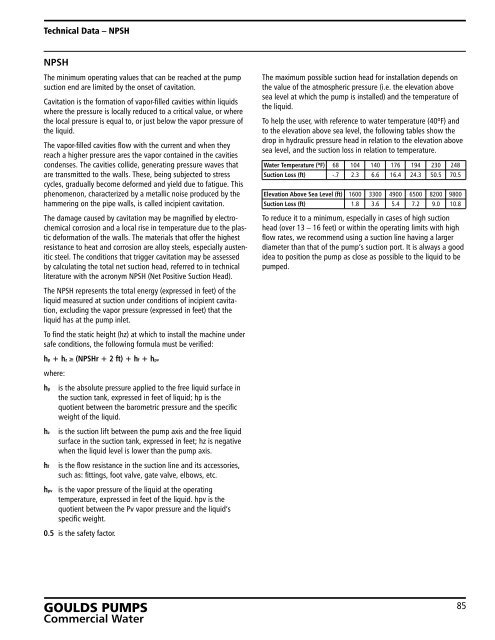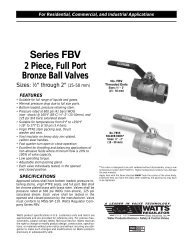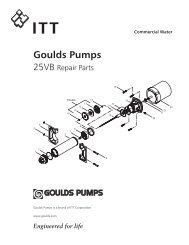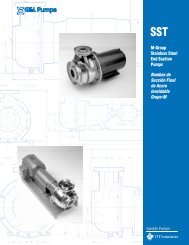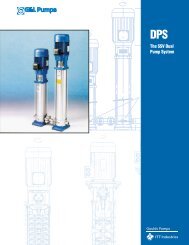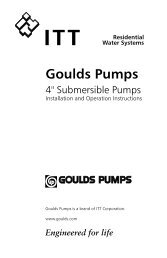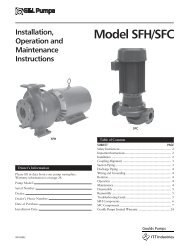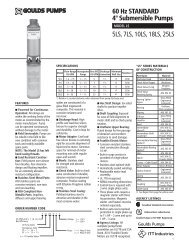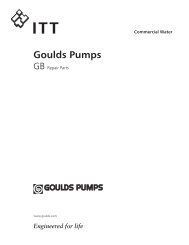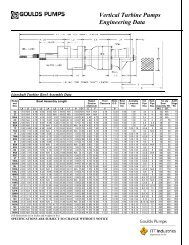ITT Goulds Pumps
ITT Goulds Pumps
ITT Goulds Pumps
Create successful ePaper yourself
Turn your PDF publications into a flip-book with our unique Google optimized e-Paper software.
Technical Data – NPSH<br />
NPSH<br />
The minimum operating values that can be reached at the pump<br />
suction end are limited by the onset of cavitation.<br />
Cavitation is the formation of vapor-filled cavities within liquids<br />
where the pressure is locally reduced to a critical value, or where<br />
the local pressure is equal to, or just below the vapor pressure of<br />
the liquid.<br />
The vapor-filled cavities flow with the current and when they<br />
reach a higher pressure ares the vapor contained in the cavities<br />
condenses. The cavities collide, generating pressure waves that<br />
are transmitted to the walls. These, being subjected to stress<br />
cycles, gradually become deformed and yield due to fatigue. This<br />
phenomenon, characterized by a metallic noise produced by the<br />
hammering on the pipe walls, is called incipient cavitation.<br />
The damage caused by cavitation may be magnified by electrochemical<br />
corrosion and a local rise in temperature due to the plastic<br />
deformation of the walls. The materials that offer the highest<br />
resistance to heat and corrosion are alloy steels, especially austenitic<br />
steel. The conditions that trigger cavitation may be assessed<br />
by calculating the total net suction head, referred to in technical<br />
literature with the acronym NPSH (Net Positive Suction Head).<br />
The NPSH represents the total energy (expressed in feet) of the<br />
liquid measured at suction under conditions of incipient cavitation,<br />
excluding the vapor pressure (expressed in feet) that the<br />
liquid has at the pump inlet.<br />
To find the static height (hz) at which to install the machine under<br />
safe conditions, the following formula must be verified:<br />
hp + hz ≥ (NPSHr + 2 ft) + hf + hpv<br />
where:<br />
hp is the absolute pressure applied to the free liquid surface in<br />
the suction tank, expressed in feet of liquid; hp is the<br />
quotient between the barometric pressure and the specific<br />
weight of the liquid.<br />
hz is the suction lift between the pump axis and the free liquid<br />
surface in the suction tank, expressed in feet; hz is negative<br />
when the liquid level is lower than the pump axis.<br />
hf is the flow resistance in the suction line and its accessories,<br />
such as: fittings, foot valve, gate valve, elbows, etc.<br />
hpv is the vapor pressure of the liquid at the operating<br />
temperature, expressed in feet of the liquid. hpv is the<br />
quotient between the Pv vapor pressure and the liquid‘s<br />
specific weight.<br />
0.5 is the safety factor.<br />
GOULDS PUMPS<br />
Commercial Water<br />
The maximum possible suction head for installation depends on<br />
the value of the atmospheric pressure (i.e. the elevation above<br />
sea level at which the pump is installed) and the temperature of<br />
the liquid.<br />
To help the user, with reference to water temperature (40ºF) and<br />
to the elevation above sea level, the following tables show the<br />
drop in hydraulic pressure head in relation to the elevation above<br />
sea level, and the suction loss in relation to temperature.<br />
Water Temperature (ºF) 68 104 140 176 194 230 248<br />
Suction Loss (ft) -.7 2.3 6.6 16.4 24.3 50.5 70.5<br />
Elevation Above Sea Level (ft) 1600 3300 4900 6500 8200 9800<br />
Suction Loss (ft) 1.8 3.6 5.4 7.2 9.0 10.8<br />
To reduce it to a minimum, especially in cases of high suction<br />
head (over 13 – 16 feet) or within the operating limits with high<br />
flow rates, we recommend using a suction line having a larger<br />
diameter than that of the pump’s suction port. It is always a good<br />
idea to position the pump as close as possible to the liquid to be<br />
pumped.<br />
85


